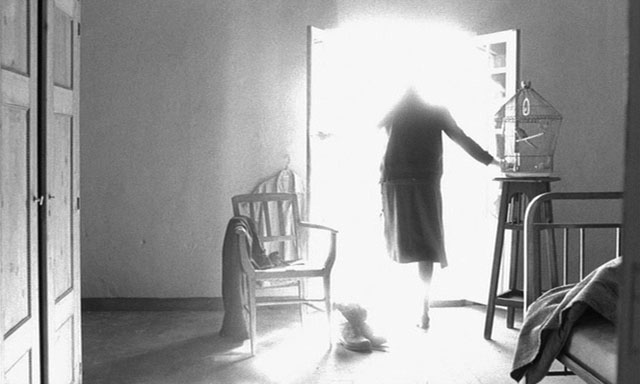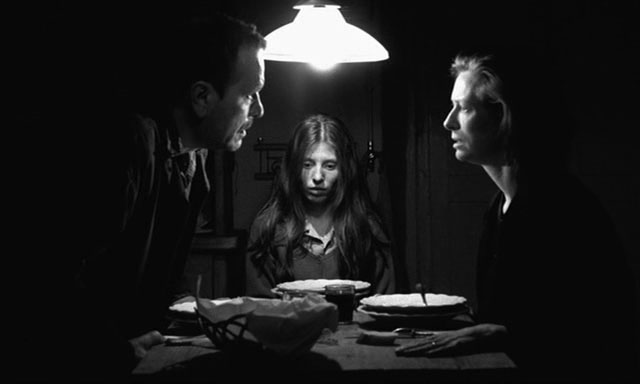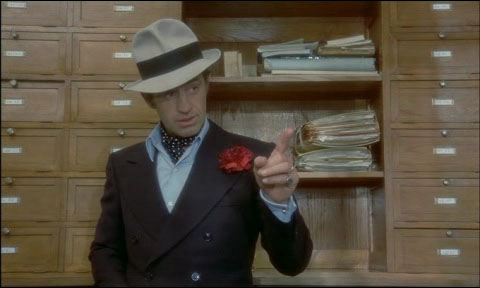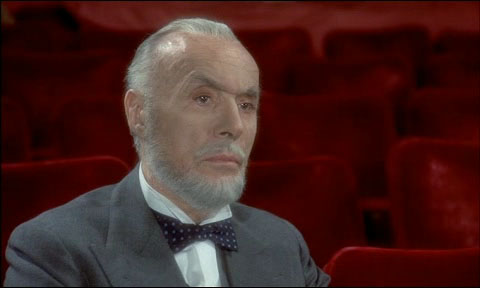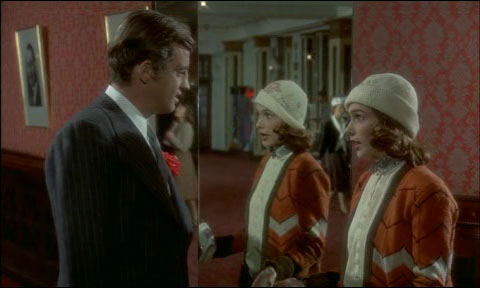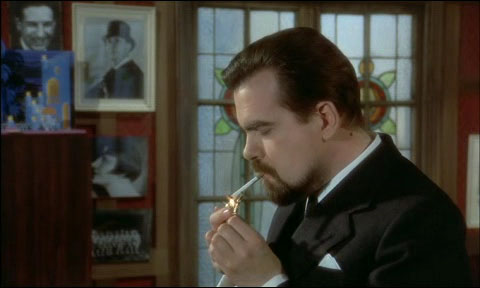Finally out on video, I got to watch this seven years after seeing Out 1 in theaters.
Rosenbaum calls the two films “radically different,” but to me, it often felt simply like a shorter version of Out 1. Of course, having seen the longer version, I can’t help noticing major differences. The two theater groups’ rehearsal footage is almost entirely gone. Renaud’s disappearance with Quentin’s money is obliquely shown, and the ensuing city-wide hunt for him is even more obliquely included, in the form of black-and-white stills from those scenes inserted between regular scenes, accompanied by a low buzzing noise. There are other appearances of stills, some from deleted scenes from the longer version, sometimes callbacks or flash-forwards to scenes within Spectre.

Admittedly the 13 group felt like a much bigger deal in Spectre, more of a central conspiracy to the film, and I was able to follow the relationships and stories of offscreen characters Pierre and Igor much better, but I can’t tell if they’re really more sharply in focus in Spectre than Out 1, or if during Out 1 itself I was too busy trying to keep the many onscreen characters straight to follow much Igor drama. But looking through articles I quoted in my original Out 1 writeup, Rosenbaum said Out 1 was shaped by “the successive building and shattering of utopian dreams” and Lim says it “devotes its second half to fracture and dissolution,” and that theme and structure didn’t feel as true of Spectre.



The buzzing stills interrupt and fragment primary scenes, and there appears to be more cross-cutting between scenes than in the long version. Conversations sometimes cut off in the middle and never return. The stills appear in greater frequency at times, and disappear for long stretches at others – for instance, when Thomas first visits Sarah at the beach house and convinces her to return to Paris, the whole scene with its long shots plays out without interruption. Sometimes the editing is telling different stories than the dialogue – when Rohmer’s Balzac scholar says “secret societies,” it cuts to the Prometheus group, not returning to Rohmer for a long while.
Obade is far, an 8-hour drive southeast from Paris


Rivette:
They aren’t single frames, but simply production stills. When we tried a shorter version, our first montage ran five and a half hours. Then to make a commercially feasible length, we used the stills to tighten the editing, much the way that Jean-Luc uses titles more and more in his films, as in La Chinoise. Every time there was an editing problem he had recourse to a title. But finally we spent more time on these photos than on anything else, because there were a priori so many possibilities. We wanted the relation between the film and the stills to be neither too close nor too distant, so it was very difficult to find just the right solution. Then we added the sound to the stills. They didn’t work without sound, because the silences interrupted either noises that were very loud or others that were just murmurs. Silence didn’t produce the effect we wanted. I wanted something purely artificial: what we have is just a meaningless frequency, as if produced by a machine, which interrupts the fiction — sometimes sending messages to it, sometimes in relation to what we’ve already seen or are going to see, and sometimes with no relation at all. Because there are stills from scenes, especially toward the end, which don’t appear in the body of the film and are frankly quite incomprehensible.
Hand-off:
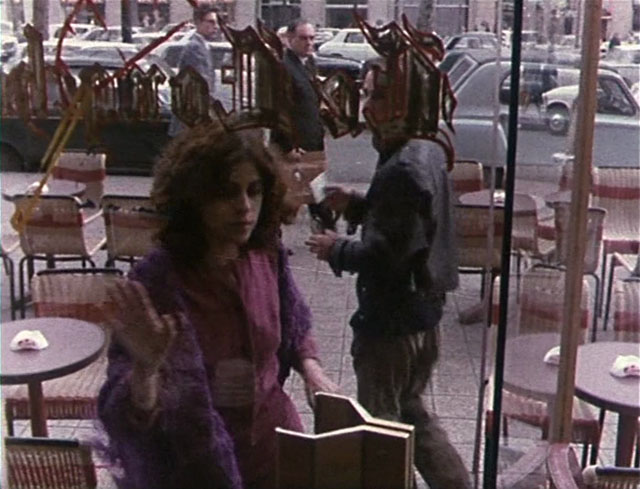


At the halfway point, after Colin, Frederique and Emilie/Pauline just appeared in the same scene, it lets loose with a whole montage of the buzzy stills. When Rivette says “there is a moment, one single shot even, in which almost all the fictions intersect, as if all these lines had to pass through a ring. This shot we put squarely in the middle: it comes just before the intermission,” is this the scene he means? There was no intermission in the DVD version, but it seems likely.

Ten of the 13: Thomas, Lili, Sarah, Pauline, Lucie (legal advisor), Warok, Etienne (chess player), The Ethnologist, Igor (never seen), Pierre (never seen). Four more whom I suspect: Elaine (because she discusses Lili’s disappearance with Lucie), Marie (because she gives Colin the letters), Iris (because Pauline speaks freely about Igor and her blackmail plot in front of her) and Georges (unseen character I mentioned in my Out 1 writeup, though I can’t recall who he is).
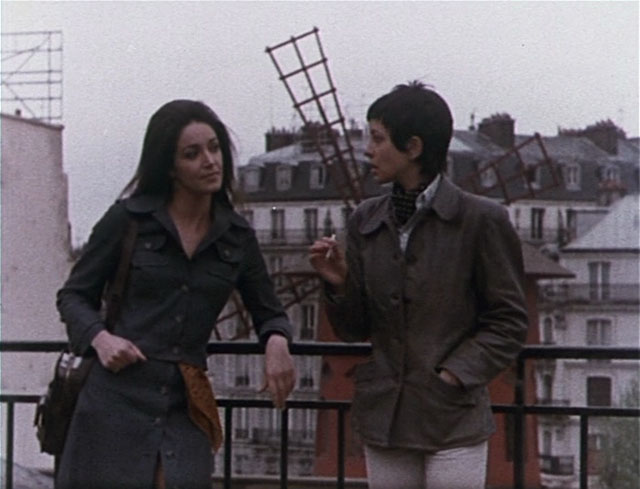
But let’s not read too much into the conspiracy. Rivette again:
In Out, I was already more careful, because the idea of the “thirteen” came rather late. For a long time we thought that the characters might never meet; perhaps there would be five or six completely different stories. We just didn’t know. Still, I had the idea that something should bring them together, and so it was Histoire des treize. But it was just a mechanism. In Paris and, even more, in Out, I don’t take the whole idea of the search for meaning seriously. It was a convenience to bring about the meetings, but it didn’t work with either film, because they were taken to be films about a search. I tried and failed to make people understand, as the film progressed, that this search led to nothing: at the end of Paris, we discover that the Organization doesn’t exist; and the more Out progresses, the more evident it becomes that this new organization of the thirteen which appeared to have been formed never really existed. There had only been a few vague conversations between completely idealistic characters without any real social or political roots. In each case there was a first part where we assembled a story of a search, and a second part where little by little we wiped it out… When I decided to use Histoire des treize, it was as a critique of Paris, which tried to show more clearly the vanity of this kind of utopian group, hoping to dominate society. It begins by being fascinating and tempting, but in the course of the film comes to be seen as futile.
equipage equipage equipage equipage equipage equipage equipage:


“Listen baby, I’m not Marlon. Marlon is on the waterfront.”

Lili and Pauline are somehow connected in running the shop (which advertises Bob Dylan bootlegs for sale in the window), and Sarah sneaks in and out. I thought Sarah was hanging out in the basement, but when they knock out Lorenzo’s man and drag him downstairs, it doesn’t look like much of a place to spend time. Lili is later said to have stolen a million francs and disappeared – but from Lorenzo or from the cases full of important-looking papers beneath the shop, I’m not positive.

Both theater groups begin with “rehearsals” that seem more like acting warm-up activities, then into vague explorations of theme and character. Each group gets a shot in the arm from the entry of a new member – Sarah to Prometheus and Renaud to Thebes. But Renaud’s ideas don’t work for Lili, and she begins to retreat from the group. In the end, both groups have dissolved because their most recent members have left, followed soon by leaders Lili and Thomas to Obade.
More important differences in the ending: Thomas doesn’t have his beachside breakdown, and Frederique doesn’t die (not sure that she even meets Renaud).

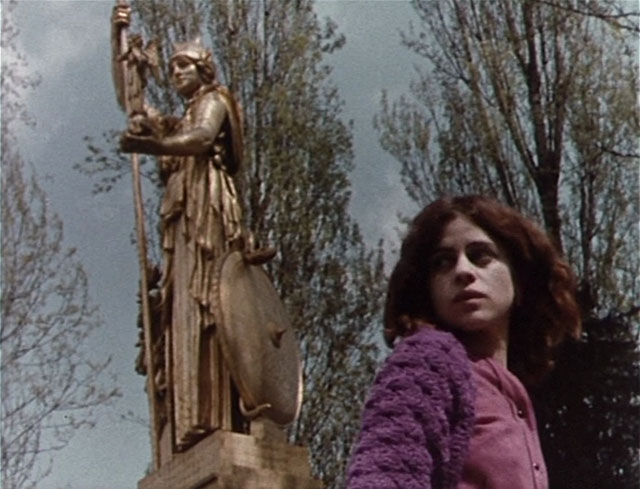
Shortly before Pauline’s lover Igor reappears (in the form of a phone call to the beach house), this maybe-strangely-translated conversation – Lili: “Why do you imagine Igor’s in a room here?” Pauline: “Imagine someone is a half, or a full year trapped in a house. No one notices. In the basement, on the floor, in a room.” Lili: “But this is a dream.” Then they agree to search the house for him, but there’s one section to which nobody has the key, and later when the key mysteriously appears, Pauline searches the unoccupied rooms beyond, staring into the infinite mirror. I find this piece of the film interesting since Bulle Ogier (Pauline) would appear in Rivette’s next film as a ghost trapped within a dream house.

Rosenbaum: “The coded messages Leaud intercepts are significantly different in the two films.” Different how? Also: “Much as Thomas Pynchon in Gravity’s Rainbow bears witness to mid-century paranoia by turning imaginary plots into real ones and vice versa, Rivette has a chilling way of both suggesting explanations and dispersing them in this monumental, maddening epic.”

Rivette:
There are some sequences which I think are failures, but after a certain number of hours, the whole idea of success and failure ceases to have any significance. Some things that I couldn’t use in Spectre are all right in the longer version. The whole actor-spectator relationship is totally different in Out, because there the actors are much more actors than characters. There are many more scenes where the sense of improvisation is much stronger, even to the point of admitting lapses, hesitations, and repetitions. There are some of these in Spectre, but relatively few, because we treated it much more as a fiction about certain characters. In the longer version, the dramatic events are a lot more distant from each other, and between them are long undramatic stretches… contrary to what most people believe, one doesn’t learn any more in the long version than in the short one.

On the meaning of the opening title “Paris and its double”:
I wanted the two titles to indicate that the film was shot in April and May 1970 – that, for me, is the important thing, since there are many allusions in the dialogue to that period. It should be evident that the group of thirteen individuals had probably met and talked for some time until May 1968, when everything changed and they probably disbanded.

David Thomson:
Out 1: Spectre begins as nothing more than scenes from Parisian life; only as time goes by do we realize that there is a plot — perhaps playful, perhaps sinister — that implicates not just the thirteen characters (including Léaud, as the mystery’s self-styled detective), but maybe everyone, everywhere. Real life may be nothing but an enormous yarn someone somewhere is spinning.





























